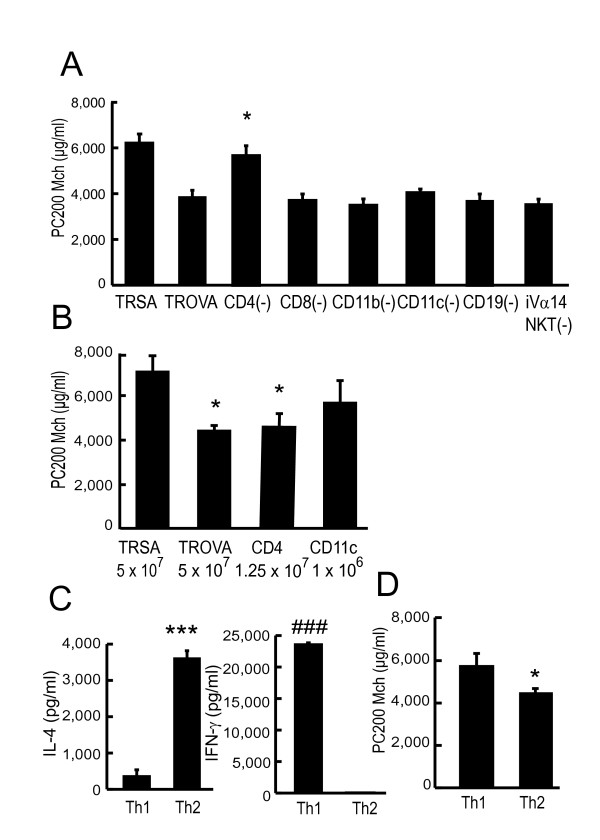Figure 8.
CD4+ Th2 cells directly induce AHR. (A) Depletion study. Recipients received spleen cells (5 × 107) from SA-treated mice (TRSA) or OVA-sensitized mice (TROVA). Other recipients received CD4+cell-depleted (CD4(-)), CD8+ cell-depleted (CD8(-)), CD11b+ cell-depleted (CD11b(-)), CD11c+ cell-depleted (CD11c(-)), CD19+ cell-depleted (CD19(-)), or iVα14 NKT cell-depleted (iVα14 NKT(-)) spleen cells from OVA-sensitized mice (5 × 107 each), respectively. AR was measured 4 days after the transfer (n = 6–10 per group). * p < 0.05 compared with PC200Mch of TROVA. (B) Effect of CD4+ or CD11c+ cells on transfer-mediated AHR. Recipients received unfractionated spleen cells from SA-treated mice (TRSA; 5 × 107), or unfractionated (TROVA; 5 × 107), CD4+ (CD4; 1.25 × 107), or CD11c+ (CD11c; 1 × 106) spleen cells from OVA-sensitized mice. AR was measured 4 days after the transfer (n = 5–8 per group). * p < 0.05 compared with PC200Mch of TRSA. (C) Polarization to Th1 or Th2 phenotype. On day 18, spleen cells (5 × 106 cells/ml) from OVA-sensitized mice were incubated with OVA (200 μg/ml) for 4 days in vitro. For polarization toward Th1 cells, IL-12 and anti-IL-4 Ab were added to the culture medium. For polarization toward Th2 cells, IL-4 and anti-IL-12 Ab were added. On day 22, positively selected CD4+ T cells were cultured with freshly isolated mitomycin C-treated splenocytes and OVA (200 μg/ml). After 96 hours, IL-4 and IFN-γ concentrations in the supernatants were assayed. *** p < 0.001 compared with the value of the CD4+ Th1 cells. ### p < 0.001 compared with the value of the CD4+ Th2 cells. (D) Effect of Th1 or Th2 phenotype on transfer-mediated AHR. Recipients received CD4+ Th1 or Th2 cells (5 × 105). AR was measured 4 days after the transfer (n = 5–6 per group). * p < 0.05 compared with PC200Mch of mice that received CD4+ Th1 cells.

